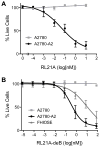Human Leukocyte Antigen-Presented Macrophage Migration Inhibitory Factor Is a Surface Biomarker and Potential Therapeutic Target for Ovarian Cancer
- PMID: 26719579
- PMCID: PMC4747837
- DOI: 10.1158/1535-7163.MCT-15-0658
Human Leukocyte Antigen-Presented Macrophage Migration Inhibitory Factor Is a Surface Biomarker and Potential Therapeutic Target for Ovarian Cancer
Abstract
T cells recognize cancer cells via HLA/peptide complexes, and when disease overtakes these immune mechanisms, immunotherapy can exogenously target these same HLA/peptide surface markers. We previously identified an HLA-A2-presented peptide derived from macrophage migration inhibitory factor (MIF) and generated antibody RL21A against this HLA-A2/MIF complex. The objective of the current study was to assess the potential for targeting the HLA-A2/MIF complex in ovarian cancer. First, MIF peptide FLSELTQQL was eluted from the HLA-A2 of the human cancerous ovarian cell lines SKOV3, A2780, OV90, and FHIOSE118hi and detected by mass spectrometry. By flow cytometry, RL21A was shown to specifically stain these four cell lines in the context of HLA-A2. Next, partially matched HLA-A*02:01+ ovarian cancer (n = 27) and normal fallopian tube (n = 24) tissues were stained with RL21A by immunohistochemistry to assess differential HLA-A2/MIF complex expression. Ovarian tumor tissues revealed significantly increased RL21A staining compared with normal fallopian tube epithelium (P < 0.0001), with minimal staining of normal stroma and blood vessels (P < 0.0001 and P < 0.001 compared with tumor cells) suggesting a therapeutic window. We then demonstrated the anticancer activity of toxin-bound RL21A via the dose-dependent killing of ovarian cancer cells. In summary, MIF-derived peptide FLSELTQQL is HLA-A2-presented and recognized by RL21A on ovarian cancer cell lines and patient tumor tissues, and targeting of this HLA-A2/MIF complex with toxin-bound RL21A can induce ovarian cancer cell death. These results suggest that the HLA-A2/MIF complex should be further explored as a cell-surface target for ovarian cancer immunotherapy.
©2015 American Association for Cancer Research.
Conflict of interest statement
Figures





References
Publication types
MeSH terms
Substances
Grants and funding
LinkOut - more resources
Full Text Sources
Medical
Research Materials
Miscellaneous

